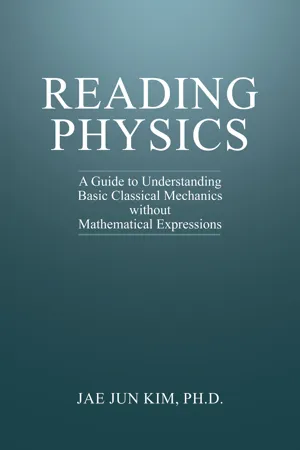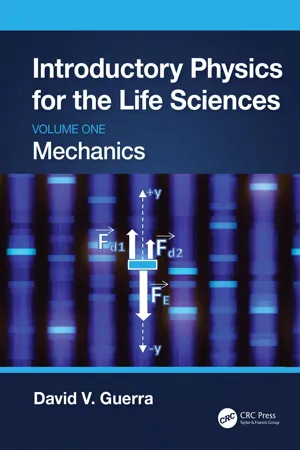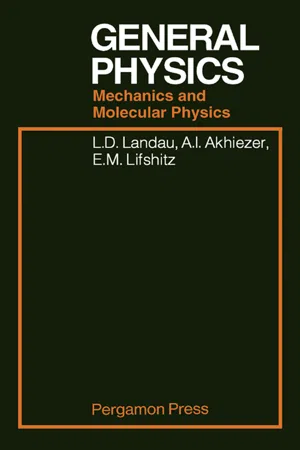Physics
Rotational Inertia
Rotational inertia, also known as moment of inertia, is a measure of an object's resistance to changes in its rotation. It depends on the object's mass distribution and the axis of rotation. Objects with larger rotational inertia require more torque to change their rotational motion, while those with smaller rotational inertia can rotate more easily.
Written by Perlego with AI-assistance
Related key terms
9 Key excerpts on "Rotational Inertia"
- eBook - ePub
- Michael M. Mansfield, Colm O'Sullivan(Authors)
- 2020(Publication Date)
- Wiley(Publisher)
The value of the moment of inertia will differ with a different distribution of mass about the same axis, that is with a different set of values of m i and r i. In general, the moment of inertia of any given body will also be different if we take a different axis. For example if, as indicated in Figure 7.13, we take an axis of rotation through B at the edge of the body, the mass elements are, on average, further from the axis and consequently the moment of inertia is larger (I B > I A). It is clear therefore that, for a stated value of a moment of inertia to have any useful meaning, the axis about which it is determined must be specified. Figure 7.13 The moment of inertia of a rigid body about an axis perpendicular to the page through B is greater than its moment of inertia about a parallel axis through A. Since we have defined both angular momentum and angular velocity as vector quantities and, in this case, both are directed along the axis of rotation, Equation (7.10) can be written as a vector equation as follows (7.12) Comparing this with the definition of momentum as a vector (P ≔ m v) we observe a significant analogy between moment of inertia in rotational motion and mass in translational motion. When the axis of rotation is fixed, moment of inertia may be treated as a scalar quantity, like mass in translational motion. In Chapter 3 we noted that mass represents a measure of how a body responds to an applied force, in the sense that it proves more difficult to give a large mass a translational acceleration than it is to give a small mass the same acceleration - No longer available |Learn more
- Robert A. Pelcovits, Joshua Farkas(Authors)
- 2023(Publication Date)
- Barrons Educational Services(Publisher)
7Rotation II: Inertia, Equilibrium, and Combined Rotation/Translation
Learning Objectives
In this chapter, you will learn:Calculation of moment of inertia for complex objectsParallel axis theoremAngular momentumNewton’s second law for rotational motion in terms of angular momentumConservation of angular momentumRolling without slippingStatic equilibrium for extended objectsRecall the definition of Rotational Inertia (where r is the distance between each differential mass and the axis of rotation).Definition of Rotational InertiaCalculations of the Rotational Inertia for point masses, rings rotating about their axes, and cylindrical shells rotating about their axes (as shown in Figure 7.1 ) are straightforward because all the differential masses share a common r.Rotational Inertia for point masses, rings, and cylindrical shells rotating about their axesWhat about more general objects where every differential mass does not share a common distance from the axis of rotation? In this more general case, we must proceed as we did with center-of-mass calculations for continuous masses: Divide the object into differential masses, calculate the Rotational Inertia of each differential mass, and sum these contributions to the total Rotational Inertia in an integral.Figure 7.1For one-dimensional objects, the differential regions consist of points (differential line segments). While it would also be perfectly valid to divide two- or three-dimensional objects into pointlike differential areas, summing these points would require double or triple integrals. As in center of mass calculations, to avoid the use of multiple integrals, we can divide two- or three-dimensional mass distributions into carefully chosen two- or three-dimensional differential regions. We must choose these two- or three-dimensional differential regions such that every particle of mass in a given differential region shares a common radius from the axis of rotation, allowing us to calculate the Rotational Inertia of the differential regions using the equation dI = r2 dm - eBook - ePub
Reading Physics
A Guide to Understanding Basic Classical Mechanics without Mathematical Expressions
- Jae J. Kim(Author)
- 2023(Publication Date)
- Universal Publishers(Publisher)
Let us look at the colors. You might already have noticed that the items in light gray are ones that change as a function of time and the ones in gray are not. For instance, in a linear motion, the positions in the horizontal and vertical directions change, so they are colored gray. In a rotational motion, the size does not change, so it is colored gray. Given all that, here comes an important question. If angle is something that is going to change, but the distance and the mass are not, why not combine the ones that do not change together? Answer: That is exactly where we introduce the moment of inertia. In a rotational motion, the moment of inertia is not going to change as a function of time. In short, we can treat the moment of inertia just like we do mass in a linear motion.Remember that we do not always need to introduce the moment of inertia to describe rotational motion. It is just that introducing the quantity makes studying and understanding the rotational motion easier, so do so. We take the quantities that change as a function of time from the ones that do not change. When combining all the quantities that do not change, as colored in gray in Figure 33.1 , we end up with the moment of inertia in a rotational motion.How do we define the moment of inertia mathematically? It is mass multiplied by distance squared. Is that the end of the story? Probably not. For a test particle, it is as simple as that. If there is a point and if we are to describe its moment of inertia, that is all we need to understand. However, when calculating the size of the moment of inertia, we calculate the momentum of inertia for an individual piece of mass within the object and add them up together in the end, which is where we need to introduce calculus.For instance, the moment of inertia for a ring with respect to a line passing the center is just mass multiplied by the radius of the ring. However, when you do the same but for a solid sphere, an individual chunk of mass within the sphere has a different distance with respect to the center of the sphere, so we need to introduce calculus to calculate the total moment of inertia associated with the shape of the object; you do the same for any other object with a different shape.Figure 33.1: In a two-dimensional linear motion, we need two quantities in length and one in mass to describe its motion. In a rotational motion, what do we need instead?Figure 33.2: Imagine that we have a solid sphere that rotates with respect to an axis that passes through the center. The two small circles in the figure represent the two infinitesimally small pieces within the sphere. In terms of the displacement associated with the two small pieces per rotation of the sphere, the size of the displacement is going to be larger for the one that is farther from the axis, which is the one with the larger size arrow in light gray. Question: how do you accommodate for the difference in the distance to the rotational axis when calculating the size of the moment of inertia? We cannot simply assume that the moment of inertia is going to be simply the total mass times the radius squared. Why? All the small pieces shown in the figure have different sizes for distance. - eBook - ePub
- John Chiasson(Author)
- 2022(Publication Date)
- Wiley(Publisher)
5 Rigid Body Rotational Dynamics 5.1 Moment of Inertia The equation s of motion of a rigid body that is constrained to rotate about a fixed axis are reviewed here briefly. Consider the cylinder shown in Figure 5.1. Figure 5.1 Cylinder constrained to rotate about a fixed axis. The approach here is to obtain the equations of motion of the cylinder by first obtaining an expression for its kinetic energy. To do so, denote the angular speed of the cylinder by and the mass density of the material making up the cylinder by. Then consider the cylinder to be made up of a large number of small pieces of material where the th piece has mass This is illustrated in Figure 5.2. Each piece of mass is rotating at the same angular speed so that the linear speed of is where is the distance of from the axis of rotation. The kinetic energy of is given by Figure 5.2 Cylinder is considered to be made up of small masses The total kinetic energy is then Dividing the cylinder into f iner and finer pieces so that and, the sum becomes the integral The quantity is called the moment of inertia. Using the kinetic energy of the cylinder may now be written as Taking the axle radius to be zero, the moment of inertia of the cylinder (assuming the mass density is constant) is computed to be where is the total mass of the cylinder. 5.2 Newton's Law of Rotational Motion The kinetic energy is now used to derive a relationship between torque and angular acceleration. Recall from elementary mechanics that the work done on a mass by an external force equals the change in its kinetic energy - eBook - ePub
- Fletcher Dunn, Ian Parberry(Authors)
- 2011(Publication Date)
- A K Peters/CRC Press(Publisher)
inertia tensor . This mathematical artifact is a result of the physical fact that an object’s resistance to rotational acceleration is anisotropic: it can be easier to rotate an object about one axis compared to another. For example, compare the torque required to spin a piece of rebar around like a helicopter versus rolling it about its lengthwise axis.Notice that J is a symmetric matrix. One trivial (but thankful) consequence of this is that we can be sloppy with row and column vectors, while ordinarily we must be very careful in order to avoid transposed results.1919 Remember, our convention in this book is to use row vectors, since the majority of matrices encountered in 3D interactive applications are transformation matrices, and the left-to-right reading order is a useful advantage. In the derivation above, we used column vectors for pedagogical and aesthetic purposes (the inertia tensor is not a transform matrix), but shame on us for being inconsistent. From here on out, we’ll stick with our convention and put the vectors on the left.Before we look at some other properties of J , let’s finish extending the basic formulas in three dimensions with perhaps the most important one.In the plane, the rotational equivalent of Newton’s second law, F = ma , is τ = Jα . Extending this into three dimensions is straightforward.3D Rotational Analog of Newton’s Second Lawτ = α J .As we’ve said before, in computer simulations it’s often the case that the force and mass are known, and we compute the acceleration using a = F /m . A similar situation exists for rotational dynamics, where division by m is replaced with multiplication by J −1 :α = τJ.− 1As it turns out, the inverse inertia tensor is needed more frequently in digital simulations than is J - David V. Guerra(Author)
- 2023(Publication Date)
- CRC Press(Publisher)
r’s inserted into the equation to produce an expression for torque and angular acceleration.F r =(m)r 2(a r)The product (m r2 ) is defined as the moment of inertia (I) so that the version of Newton’s Second Law for rotational systems can be written in vector form in equation (13.10) as:(13.10)τ ⇀= Iα ⇀Notice that the restriction put on this derivation is that the applied force is perpendicular to the line from the axis of rotation to the location of the applied force. This restriction does not severely limit the use of equation (13.10), since many systems include rolling wheels or chains on the sprockets of a bicycle have this orientation.So, for a mass, m, rotating at a distance, r, from the center of rotation, as shown in Figure 13.9 , the moment of inertia is (mr2 ).FIGURE 13.9 A mass, m, at a distance, r, from a rotation point and moving with an angular velocity, ω.Therefore, the moment of inertia, I, of an object is in effect the “rotational mass” of an object. It has units of [(kg)(m2 )] and is always proportional to (mr2 ), but for different objects, the moment of inertia has different fractions in the front of the mr2 that represents the distribution of the mass of the object around the rotational axis. For example, if the mass of the object in Figure 13.9 is distributed evenly around the circumference, the object is a hoop, as shown in Figure 13.10 , it has the same moment of inertia, mr2- eBook - ePub
- A. L. Stanford, J. M. Tanner(Authors)
- 2014(Publication Date)
- Academic Press(Publisher)
For example, if the rotation of a body in a problem takes place about a fixed axis, the problem involves pure rotation; we may then ignore any translational aspects of the rotating body. The kinetic energy of the body is then given by K = 1/2 I ω 2. If the system under consideration is a rigid body rotating about a fixed axis, any particle located at a distance r from the axis of rotation has translational displacement, tangential speed, and tangential acceleration related to its angular variables by s = r θ, v t = r ω, and a t = r α. If a rotating body in a problem is not rigid, that is, if the distances between particles that comprise the body change, the problem is probably one that utilizes the principle of conservation of angular momentum. Before we conclude that the angular momentum of a system is conserved, we must be certain that external forces produce no net torque on the system (the necessary condition for conservation of angular momentum). When angular momentum of a system is conserved, the equation I i ω i = I f ω f relates the angular velocities and moments of inertia of the system before (initially) and after (finally) the configuration has been changed to give the system a different moment of inertia. Rolling (or unwinding) bodies translate and rotate simultaneously. If they roll without slipping, the equations s = r θ, v t = r ω, and a t = r α relate the translational and rotational variables of points on or within the rolling body - eBook - ePub
General Physics
Mechanics and Molecular Physics
- L D Landau(Author)
- 2013(Publication Date)
- Pergamon(Publisher)
Here the constancy of Ω follows from that of L z because we have assumed that the body itself is unchanged during the rotation, i.e. its moment of inertia is unchanged. If the relative position of the parts of the body, and therefore its moment of inertia, vary, then in free rotation the angular velocity will also vary in such a way that the product I Ω remains constant. For example, if a man holding weights in his hands stands on a platform rotating with little friction, by extending his arms he increases his moment of inertia, and the conservation of the product I Ω causes his angular velocity of rotation to decrease. §28. The equation of motion of a rotating body The equation of motion of a particle gives, as we know, the relation between the rate of change of its momentum and the force acting on it (§7). The translational motion of a rigid body is essentially the same as the motion of a particle, and the equation of this motion consists of the same relation between the total linear momentum P = M V of the body and the total force F acting on it: d P/ d t = M d V / d t = F. In rotational motion there is a corresponding equation relating the rate of change of the angular momentum of the body to the torque acting on it. Let us find the form of this relation, again taking the simple case of rotation of the body about a fixed axis Z. The angular momentum of the body about the axis of rotation has already been determined. Let us now consider the forces acting on the body. It is clear that forces parallel to the axis of rotation can only move the body along that axis and can not cause it to rotate. We can therefore ignore such forces and consider only those in the plane perpendicular to the axis of rotation. The corresponding torque K z about the axis Z is given by the magnitude of the vector product r × F, where r is the vector giving the distance of the point of application of the force F from the axis - eBook - ePub
- Robert Lambourne(Author)
- 2019(Publication Date)
- CRC Press(Publisher)
r .4 The conditions for mechanical equilibrium areThese conditions are necessary, but not sufficient, to ensure static equilibrium.(4.14)and∑ iF i= 0= 0 .∑ iΓ i5 There are three types of static equilibrium: stable, unstable and neutral.6 The moment of inertia I , about a given axis, for a system of particles isI =(4.23)∑ im ir i2whereriis the perpendicular distance from the axis to the i th particle, andmiis the mass of that particle. Note that the moment of inertia of a system depends on the axis about which it is determined.7 The moment of inertia I about a given axis for a rigid body has a similar significance, though its evaluation usually involves a definite integral rather than a sum. (Some results are given in Figure 4.37 .)8 For a body rotating with angular speed ω, about a fixed axis associated with moment of inertia I , the rotational kinetic energy is given by.E rot=1 2Iω 2.9 When the centre of mass of a rigid body of mass M has speed υ CM , and the body rotates with angular speed ω about an axis through the centre of mass, and has a moment of inertia I CM with respect to that axis then, the total kinetic energy of the body is given by(4.27)E kin=E trans+E rot=1 2Mv CM 2+1 2I CMω 2.10 A constant torque Γ acting over an angular displacement Δθ does an amount of work W = Γ Δθ and transfers energy at a rate given by the power P = Γ · ω.
Index pages curate the most relevant extracts from our library of academic textbooks. They’ve been created using an in-house natural language model (NLM), each adding context and meaning to key research topics.








